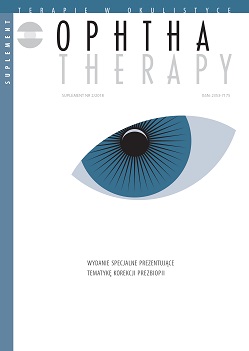Refraction lens exchange vs. laser refraction surgery in presbyopia. Who qualifies and why?
Main Article Content
Abstract
Presbyopia is a problem which affects most of the adult population of over forty-year-old and almost all after fifty-year-old. Both corneal refractive surgery or lens exchange procedures bring a solution to the problem. First of mentioned methods which have a longer history, constitute a certain compromise in accommodation loss treatment, whereas refraction surgery based on lens exchange procedures using multifocal lenses is currently a more satisfactory solution to the problem. The key to obtain success after surgery, is to adequately select the patient. Our own experience concerning Alcon AcrySof® IQ Pan- Optix® and PanOptix Toric® (Alcon) multifocal lenses shows that this has been the best solution to the problem of presbyopia so far.
Downloads
Article Details

This work is licensed under a Creative Commons Attribution-NonCommercial-NoDerivatives 4.0 International License.
Copyright: © Medical Education sp. z o.o. License allowing third parties to copy and redistribute the material in any medium or format and to remix, transform, and build upon the material, provided the original work is properly cited and states its license.
Address reprint requests to: Medical Education, Marcin Kuźma (marcin.kuzma@mededu.pl)
References
2. Alarcon A, Anera RG, Jimenez del Barco L et al. Designing multifocal corneal models to correct presbyopia by laser ablation. J Biomed Opt. 2012; 17(1): 1-9.
3. Mrochen M. Hyperprolate corneas for pseudo-presbyopia correction. Cataract Refr Surg Today Eur. 2009; 4(1): 28-9.
4. Reinstein DZ, Carp GI, Archer TJ et al. LASIK for the correction of presbyopia in emmetropic patients using aspheric ablation profiles and a micro-monovision protocol with the Carl Zeiss Meditec MEL80 and VisuMax. J Cataract Refr. Surg. 2012; 28: 531-41.
5. Taneri S, Oehler S. Keratectasia after treating presbyopia with INTRACOR followed by SUPRACOR enhancement. J Cataract Refr Surg. 2013; 29: 573-6.
6. Yılmaz OF, Alagöz N, Pekel G et al. Intracorneal inlay to correct presbyopia: Long-term results. J Cataract Refr Surg. 2011; 37(7): 1275-81.
7. Dexl AK, Seyeddain O, Riha W et al. One-year visual outcomes and patient satisfaction after surgical correction of presbyopia with an intracorneal inlay of a new design. J Cataract Refr Surg. 2012; 38(2): 262-69.
8. Braga-Mele R, Chang D, Dewey S et al. Multifocal intraocular lens: refractive indications and contraindications for implantation. J Cataract Refr Surg. 2014; 40: 313-22.
9. Bronicki D, Miller M, Dyda W et al. Pseudosoczewkowość po operacji zaćmy nie musi ograniczać. Soczewka trójogniskowa jako rozwiązanie problemu starczowzroczności. OphthaTherapy. 2015, 4(8): 286-91.
10. Lee BS, Chang DF. Comparison of the Rotational Stability of Two Toric Intraocular Lenses in 1273 Consecutive Eyes. Ophthalmology. 2018; 125(9): 1325-31.
11. Gundersen GK, Potvin R. Trifocal intraocular lenses: a comparison of the visual performance and quality of vision provided by two different lens designs. Clin Ophthalmol. 2017; 11: 1081-7.

